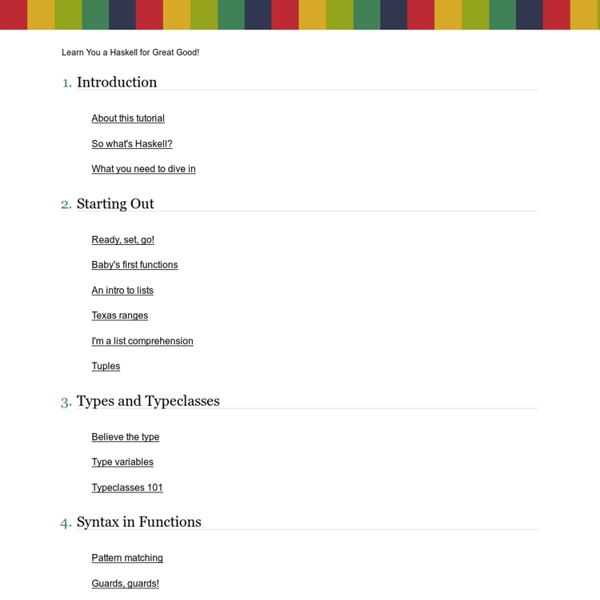



Higher-Order Perl by Mark Jason Dominus Order Higher-Order Perl online from Powell's Books Download full text here There are three versions available. You have your choice of structure or presentation, but not both. License reminder Higher-Order Perl is copyright ©2005 by Elsevier Inc. You may download the book for your personal use, but you may not distribute it to other people, either individually or by uploading it to a file-sharing service. Although the text is available for free, Higher-Order Perl is not in the public domain and is not available under a free license of any sort. This is the publisher's own PDF proof of the second version, which was sent to the printers in August 2005. This is better than the bootleg copies available from download sites in at least three ways: It is the complete text of the second printing, which incorporates many minor corrections; the bootleg copies are all bootlegs of the first printing. Download the whole book. Download individual chapters How was this created? Enjoy.
Изучай Хаскель ради добра! Аппликативные функторы Совсем недавно издательство No Starch Press подготовило и выпустило печатное издание замечательного учебника Learn You a Haskell for Great Good! (онлайн-версия), написанного Miran Lipovača. Я хочу представить вам самый актуальный перевод главы 11 Аппликативные функторы, оригиналом для которого послужило именно издание от No Starch Press, адаптированное для печати. Сочетание чистоты, функций высшего порядка, параметризованных алгебраических типов данных и классов типов в Хаскеле делает реализацию полиморфизма более простой, чем в других языках. Нам не нужно думать о типах, принадлежащих к большой иерархии. Классы типов открыты, что означает, что мы можем определить собственный тип данных, обдумать, как он может действовать, и связать его с классами типов, которые определяют его поведения. Мы говорили о классах типов, которые определяют операции для проверки того, равны ли два элемента, и сравнения двух элементов по размещению их в каком-то порядке. Функторы возвращаются Хорошо. Закон 1
De Montfort Students Union - The Home for De Montfort University Students Programming in Lua : contents This book is a detailed and authoritative introduction to all aspects of Lua programming written by Lua's chief architect. Programming in Lua provides a solid base to any programmer who wants to use Lua. It covers all aspects of Lua—from the basics to its API with C. When you buy a copy of this book, you help to support the Lua project. For the official definition of the Lua language, see the reference manual. Fourth edition The fourth edition updates the book to Lua 5.3 and marks a complete reorganization of the text. The book is available at the main online stores and also as an e-book. Third edition The third edition is aimed at Lua 5.2 and can be used with other versions. The book is available at the main online stores and also as an e-book. Second edition The second edition was aimed at Lua 5.1 and remains quite relevant for later versions. The book is still available at the main online stores. First edition The first edition was aimed at Lua 5.0 and remains largely relevant.
Почему надо знать машину Тюринга Большинство конкурсантов не знают этой азбуки, поэтому их результаты можно сравнить с творчеством программиста, не изучавшего машину Тюринга. Из рецензии читателя на литературное творчество в Интернете. Ст.-Петербург. 1997 г. Беда в том, что в отличие от высокообразованных критиков, разбирающих литературное творчество графоманов творящих в Интернете, большинство нынешних программистов не изучало ни машину Тюринга, ни машину Поста, ни нормальные алгорифмы Маркова. Однажды, давным-давно, еще в прошлом столетии, а точнее 4 апреля 1978 года мне довелось присутствовать на заседании Ученого совета Вычислительного центра АН СССР. Надо сказать, что Вычислительный центр Академии наук, несмотря на свое прикладное название, был отнюдь не счетной фабрикой, обслуживающих другие институты академии. Так вот, между членами ученого совета возникла оживленная дискуссия о правомерности защиты диссертации на степень кандидата физико-математических наук, а не на степень кандидата технических наук.
Programming Pearls by Jon Bentley. Addison-Wesley, Inc., 2000. ISBN 0-201-65788-0. 239 + xi pp. $24.95 This book is a collection of essays about a glamorous aspect of software: programming pearls whose origins lie beyond solid engineering, in the realm of insight and creativity. This book provides a guide for both students and experienced programmers about how to design and create programs, and how to think about programming. The book is full of small case studies, real examples, and interesting exercises for learning about how to program. Steve McConnell describes the book as ``a celebration of design in the small''. What's new on this web site? From The BookTable of ContentsPrefacePart I: Preliminaries Column 1: Cracking the Oyster Column 2: Aha! About The BookWhy a Second Edition? Supporting MaterialSource CodeWeb Sites Relevant to the BookAnimation of Sorting AlgorithmsTricks of the TradeTeaching Material Other Links
Настройка Ubuntu 12.04 после установки В этой статье собрано всё самое полезное из предыдущих статей по настройке систем Ubuntu и более подробно расписано. Почему лучше установить Ubuntu 12.04? Ответ очевиден, это LTS, что означает долгосрочная поддержка и стабильная версия. Скачивать нужно с официального сайта Ubuntu, не ставьте всякие редакции от различных сайтов: Приступим к действиям после установки.Для удобства навигации можете использовать оглавление. Оглавление. 1. С этого пункта стоит начинать настройку любой системы. Открываем терминал (Ctrl+Alt+T) и выполняем следующие команды: sudo apt-get update sudo apt-get upgrade Здесь хочу заметить. Всё это можно сделать и в графическом режиме: После вашего первого захода у вас на панели Unity появится вот такой значок: Так же его можно найти и в меню Dash: И откроется окно с обновлением: И если нажать "Настройки": Можно выставить настройки, когда это приложение будет проверять обновления и вам сообщать об этом. В этом диалоговом окне можно выставить сервер, откуда качать обновления:
Squeak by Example